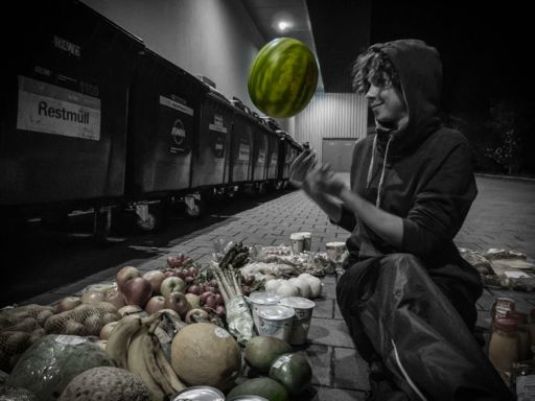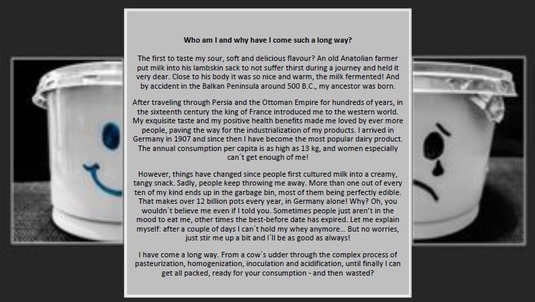Combating Food Waste: Three examples of how to save food in Munich
22.10.2015
by Sibylle Zavala, Ramona Mayr and Thomas Müller, Alumni Environmental Studies Certificate Program students

Color-coded photographs show food for sharing or distribution (pastel) or consumption (bold). Photograph: Thomas Müller.
Our final project, and that of our fellow students, was pioneering work. As a biologist, an interculturalist, and an environmental planner, we formed a rather interdisciplinary group. We wondered what we could work on that would encompass sustainability across our three fields of study: we decided on the waste of food still suitable for human consumption, which is somewhat contradictory to the concept of sustainability. As stated by the 1987 Brundtland Commission, sustainable food security should meet “the needs of the present without compromising the ability of future generations to meet their own needs.”
Food waste is an issue for environmental biology and planning because we have only limited natural resources from which to grow our food. The environmental and social consequences of food waste need to be addressed by scientists in order to understand human behavior and attitudes towards such precious goods. Contemplating on a personal level the ethical implications of wasting food, all three of us started to question our behavior and that of the affluent society in which we live. Looking at Munich, the practice of food waste in private households, and on a retail or wholesale level, seems to be accepted in German society. Nevertheless, different urban reactions have developed over recent decades: the Münchner Tafel (a food bank based in Munich), foodsharing e.V. (a registered association in Germany with a subdivision in Munich) and the practice of dumpster diving pursued by some individuals and smaller groups.
Dumpster diving. Photograph: Thomas Müller.
With this in mind, several questions began to pop into our heads: What exactly are these forms of reactions towards food waste? How do these organizations and individuals combat food waste? What stance do they take towards the wasting of still-edible food? What motivates those engaged? Does their work have the power to influence the relationship that many Germans have with food, and stop, or at least reduce, its waste? After months of productive discussions, interviews, and photoshoots, we presented our final project “Combating Food Waste: Three Examples of How to Save Food in Munich.”
In our “Context” paper we delivered facts and figures of the causes and consequences of wasting food in Germany and globally. We also conducted a series of ethnographic interviews with a focus on the attitudes towards wasting still-edible food and on the motivations of those engaged in saving it. We accompanied some of our interview partners to dumpster dive at night, to a food pickup at an organic supermarket by foodsharing e.V., and to a food distribution site of the Münchner Tafel.
For the main part of our exhibition, we explained how these three urban reactions to food waste save still-edible food. To give an insight into the manifestation of reactions to food waste by retailers and wholesalers, we created three exemplary picture stories of people involved in the organization of foodsharing, Münchner Tafel, or in the more personal pursuit of dumpster diving. Our photographic exhibition showed how food that is, or would have been, thrown away in Munich is “rescued” by group of people to eat themselves or to re-distribute it to those who would.

A personified tale of waste. Image: Thomas Müller.
As you can see, our pictures are generally black and white. To indicate two different levels of the food saving process we used two types of color-coding: the more pastel-colored fruits and vegetables were saved to be shared (foodsharing) or distributed (Münchner Tafel). The food displayed in bolder colors was taken by someone who consumed it and so saved it from being wasted. The color itself emphasized that there is hope for unsold or unwanted food to be saved in order to fulfil its purpose—to be eaten.
We wrote three stories from the perspective of personified wasted food items. Through a story of how and where the food was grown or invented, how it was transported to the supermarket in Germany, or how it feels being neglected by the average consumer, we aimed at addressing food waste with our audience on an emotional level. We tried to show the complexity and perversity of how food is shipped from all over the world to its final destination, only to be wasted.
Over the last few months, we have seen changes concerning food waste in and outside of Munich. More and more supermarkets cooperate with foodsharing, advertising it and making it public. In winter, when the dumpster dive season starts, I will give a talk about dumpster diving and food waste in Munich, addressing a bigger audience and inviting stakeholders. In France, a law set to crack down on food waste forces stores to donate unsold food to charities or for animal feed instead of throwing it away. Perhaps we’re already in a period of change and just need to keep pushing forward. One thing is certain: the amount of food being wasted and its social, as well as ecological, consequences is something we cannot overlook—every single consumer needs to tackle this!

